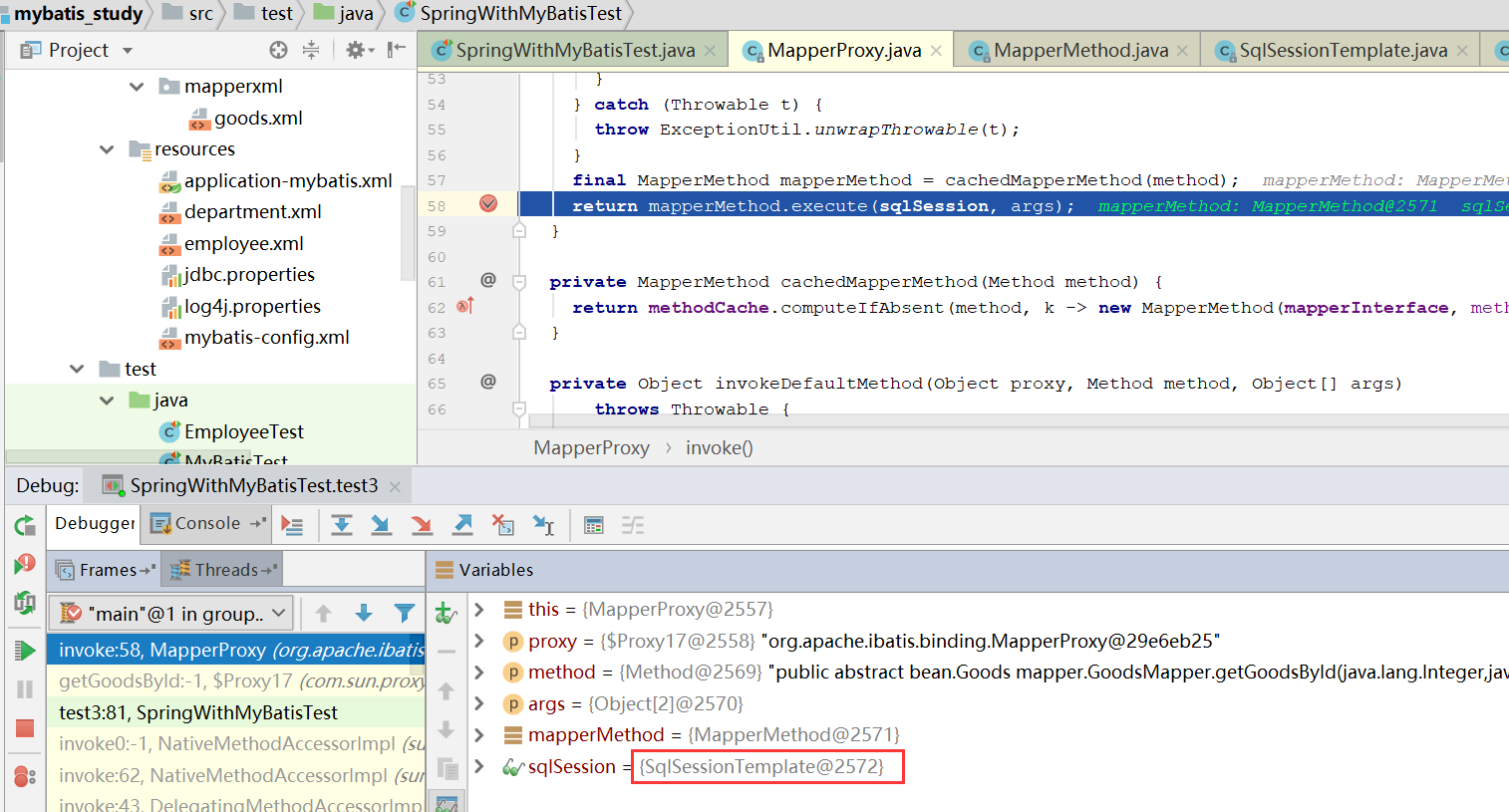问题
1、学习测试时发现了一级缓存并没有生效,先看案例:
setting配置:
<settings>
<!-- (1) 提供可控制Mybatis框架运行行为的属性信息 -->
<setting name="lazyLoadingEnabled" value="false" />
<setting name="logImpl" value="STDOUT_LOGGING" />
<setting name="localCacheScope" value="SESSION"/>
</settings>
测试代码:
@Test
public void test1(){
try(SqlSession sqlSession = sessionFactory.openSession();){
GoodsMapper goodsMapper = sqlSession.getMapper(GoodsMapper.class);
Goods goods = goodsMapper.getGoodsById(1,"电脑2");
Goods goods2 = goodsMapper.getGoodsById(1,"电脑2");
}
}
@Autowired
private GoodsMapper goodsMapper;
@Test
public void test2(){
Goods goods = goodsMapper.getGoodsById(1,"电脑2");
Goods goods2 = goodsMapper.getGoodsById(1,"电脑2");
}
问题分析
首先我们都知道一级缓存的作用范围有两种,一种是sqlSession,一种是STATEMENT。我们看test2方法,用的都是同一个mapper,按理说是应该只查询一次的啊,难道同一个mapper的sqlSession不一样。紧接着我试了test1方法,用的也都是同一个mapper,发现只查询了一次数据库。难道这两种方法有不一样的地方吗?
答案就在MapperProxy类当中,我们打断点执行test1方法,我们发现他的sqlSession类型是DefaultSqlSession

然后再执行test2方法,我们发现他的sqlSession类型是SqlSessionTemplate

他们的差别找到了,失效的原因多半就是SqlSessionTemplate造成的,SqlSessionTemplate类里有一个SqlSessionInterceptor,我们看他的invoke方法,代码如下:
private class SqlSessionInterceptor implements InvocationHandler {
@Override
public Object invoke(Object proxy, Method method, Object[] args) throws Throwable {
SqlSession sqlSession = getSqlSession(
SqlSessionTemplate.this.sqlSessionFactory,
SqlSessionTemplate.this.executorType,
SqlSessionTemplate.this.exceptionTranslator);
try {
Object result = method.invoke(sqlSession, args);
if (!isSqlSessionTransactional(sqlSession, SqlSessionTemplate.this.sqlSessionFactory)) {
// force commit even on non-dirty sessions because some databases require
// a commit/rollback before calling close()
sqlSession.commit(true);
}
return result;
} catch (Throwable t) {
Throwable unwrapped = unwrapThrowable(t);
if (SqlSessionTemplate.this.exceptionTranslator != null && unwrapped instanceof PersistenceException) {
// release the connection to avoid a deadlock if the translator is no loaded. See issue #22
closeSqlSession(sqlSession, SqlSessionTemplate.this.sqlSessionFactory);
sqlSession = null;
Throwable translated = SqlSessionTemplate.this.exceptionTranslator.translateExceptionIfPossible((PersistenceException) unwrapped);
if (translated != null) {
unwrapped = translated;
}
}
throw unwrapped;
} finally {
if (sqlSession != null) {
closeSqlSession(sqlSession, SqlSessionTemplate.this.sqlSessionFactory);
}
}
}
}
此时我们发现sqlSession是通过invoke方法里的getSqlSession方法重新赋值了,而我打断点发现,同一个mapper调同样的方法获得的sqlSession是不一样的,既然不一样,那当然读不到缓存了。
而DefaultSqlSession则是直接执行查询方法,是同一个sqlSession。所以读到了缓存。